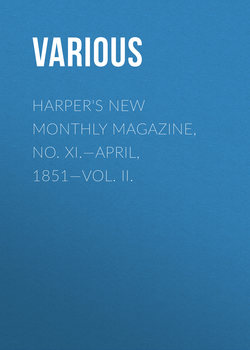Читать книгу Harper's New Monthly Magazine, No. XI.—April, 1851—Vol. II. - Various - Страница 3
THE CRYSTAL PALACE
LIFE ON SHIPBOARD
Оглавление"At half-past six I used to turn out; and, warm or cold, wet or dry, take an immediate ablution in the pure and natural element. For half an hour I would then walk on deck, fair or foul; and, a little before eight, examine the men's forecastle; see to their condition, and whether any of them were sick; and if so, give them medicine. At eight bells, I would then take the chronometrical time for Captain Forsyth, while he observed the altitude of the sun, to get our longitude. Latterly I used, by his desire, to take a set of sights also myself, taking the time from a common watch, and comparing it afterward with the chronometer. The chronometers were then wound up by me, and the thermometer, barometer, &c., registered. At eight o'clock the two mates went to breakfast; the captain and I getting ours soon after them. During the forenoon I had to attend to the stores, provisions, &c.; write my accounts, journals, and other papers; and at noon worked up the ship's reckoning, the observations, and wrote the ship's log, examining our present position and future course. The mates had their dinner at noon: the captain and I at three P.M.; after which, a stroll for an hour or so on deck was taken by both of us. Tea came round at six, and at eight P.M. I used to try the temperature of the air on deck, and of the sea. After that, we would read together in the stern cabin. At ten, we would take our hot grog; and, generally about eleven, when free from rough weather or the neighborhood of ice, turn in for the night. Very little candle was required below at night, as there was seldom more than an hour or two's darkness during any part of our voyage, until we were returning. It was not long after this date, moreover, that we had continued daylight through the whole twenty-four hours."
The principal obstruction and danger in arctic navigation arises from the ice; fields of which often occur of twenty or thirty miles in diameter, and ten or fifteen feet in thickness. From these crystal plains rise sometimes isolated, sometimes in groups, elevations of thirty or more feet in height, called hummocks. Dr. Scoresby once saw a field so free from hummocks and fissures that a coach might have traversed it for leagues in a straight direction, without obstruction. In May or June these fields begin to drift along in solemn procession to the southwestward, in which direction they hold their steady course, whether in calm or in spite of adverse winds. When these floating continents emerge from the drift ice which had hitherto protected them, they are shattered and broken up by the long, deep swell of the ocean. A ground-swell, hardly perceptible in the open sea, will break up a field in a few hours. These fields sometimes acquire a rotary motion, which gives their circumference a velocity of several miles an hour, producing a tremendous shock when one impinges upon another. "A body of more than ten thousand millions of tons in weight," says Dr. Scoresby, "meeting with resistance when in motion, produces consequences scarcely possible to conceive. The strongest ship is but an insignificant impediment between two fields in motion." – Mr. Snow gives the following account of
